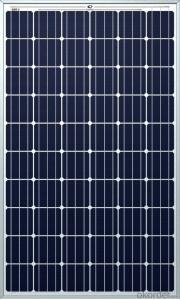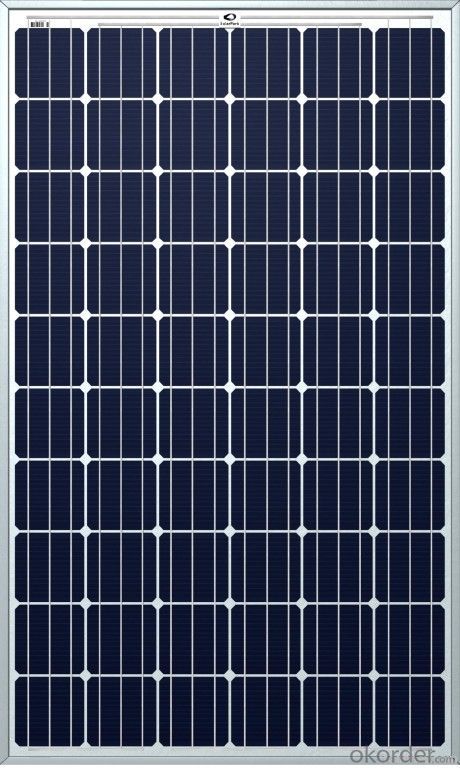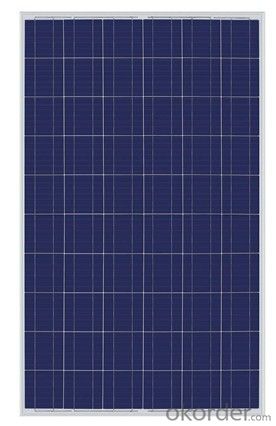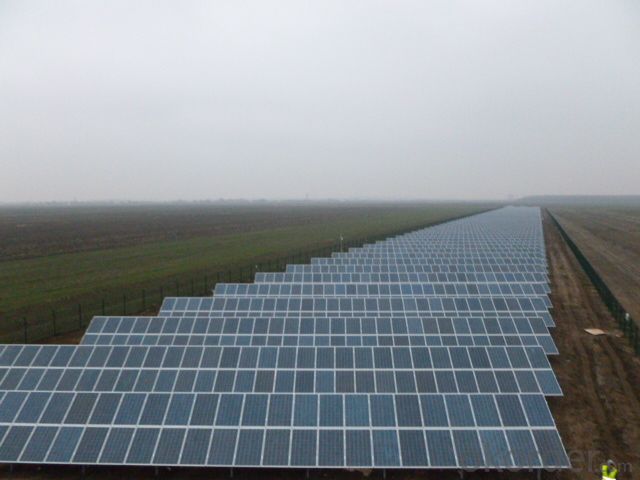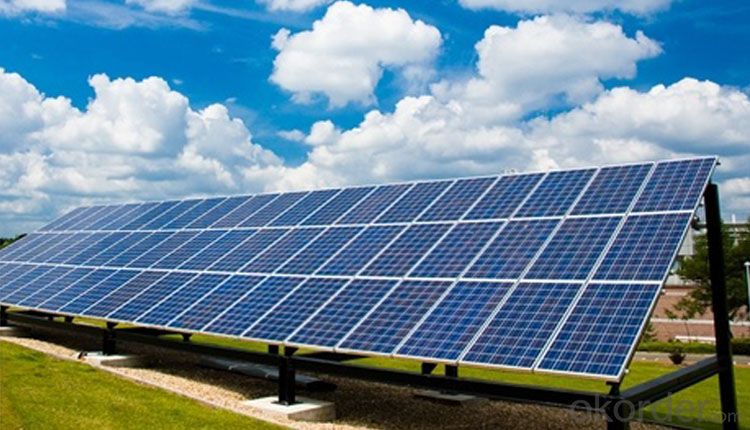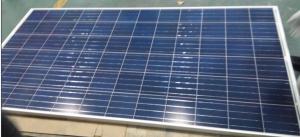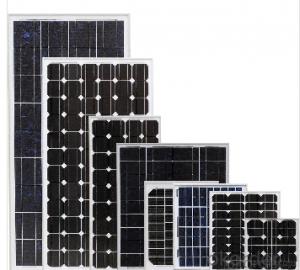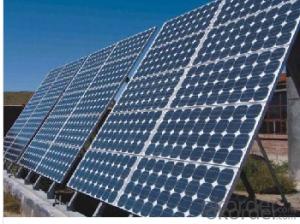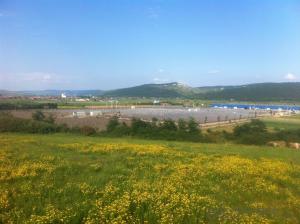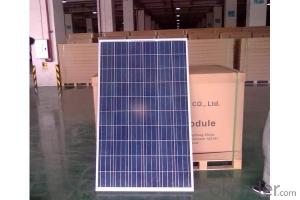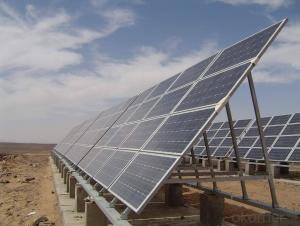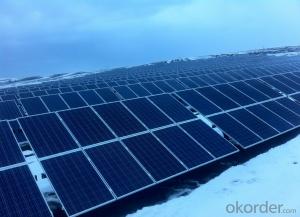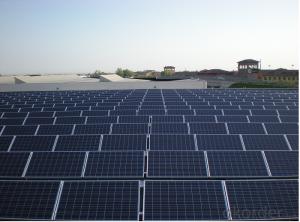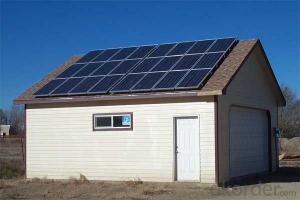CNBM Solar Monocrystalline 156mm Series 130W Solar Panels Inverters
- Loading Port:
- Shanghai
- Payment Terms:
- TT OR LC
- Min Order Qty:
- 1000 watt
- Supply Capability:
- 20000000 watt/month
OKorder Service Pledge
OKorder Financial Service
You Might Also Like
Specification
Materials
Silicon
Guarantee
12 yrs free from defects in materials and workmanship
No less than 90% within 10yrs and no less than 80% within 25yrs
TUV(IEC61215&IEC61730), CE, UL
Application
Photovoltaic/ solar/ green energy/ energy saving
Descriptions
1.High efficiency crystalline silicon solar cell. Even if under the weak light, the solar module can produce maximum power output.
2.Tempered glass (toughened glass): Anti-reflecting coating and high transmission rate glass increase the power output and mechanical strength of solar module.
3. EVA and TPT: Using high quality EVA and TPT to prevent destroying and water.
4. AI frame: Without screw, rner connection. 6 holes on the frame can be installed easily.
5. Junction box: Multi function junction box with water proof.
6. Long lifetime: ≥25 years; Less power decrease.
7. Good performance of preventing from atrocious weather such as wind and hails.
8. Resisting moisture and etching effectively, not effected by geology.
9. The certificate issued by international authority: UL, TUV, IEC, CE.
Packaging Details
26pcs/pallet, 28pallets/ 40HQ
Our solar panels are packed in cartons, and then pallet.
Shipping by sea or by air are both ok, it up to customer’s chose.
We’d like to inquiry the freight cost for customer after be informed exact quantity and destination address.
CNBM International Corporation is a professional solar panel manufacturer in China for CNBM brand . Silicon panel ( silicon module), as our main product, has high quality and good service. Our products are very popular in Europe, Australia, England, Middle East, Mexico, Argentina, Chili, Singapore and Africa.Furthermore, our products have gained international authorized certificates like TUV, UL and CE.
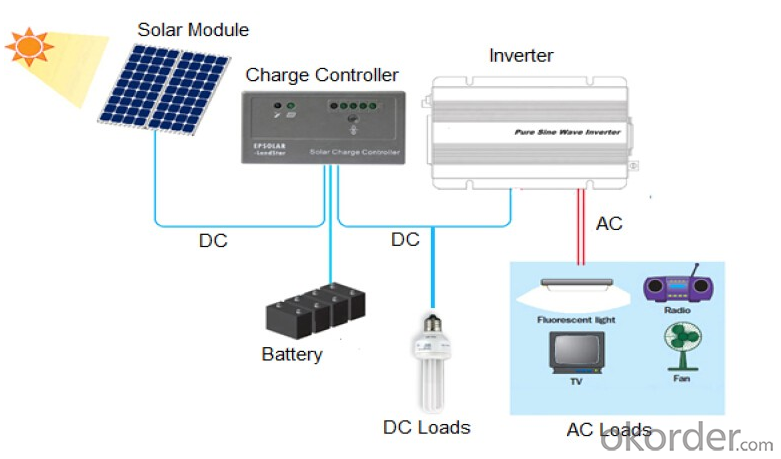
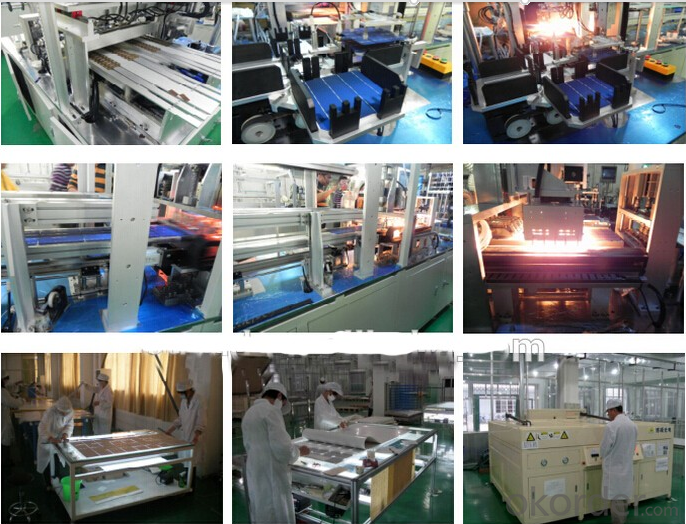

Why Choose Us
A. Professional Manufacturers , Strict quality control & power classification Silicon Solar PV Module
B. 100% A grade solar cell with Positive tolerance power range.
C. High Conversion Efficiency , High transmission rate , low iron tempered Anti-reflecting/coating film 3.2mm glass
D. Anti-aging & high visosity EVA
E. high frame resistant & Double-sided fluorine TPT
F. Anodized aluminum alloy high thickness frame
G. 3 or 6 bypass diodes , 90mm 4m2 cable , MC4 connectors & waterproof junction box
H. Long life, Easy installation, high wind & hail impact resistance
I. Be resistant to atmospheric exposure & effects of delamination
J. ISO9001:2008/ISO14001:2004/OHSAS18001:2007/ CE /TUV/CEC/ IEC/EN61215 IEC/EN61730/CHUBB INSURANCE
K. 10Years Manufacturing Quality Warranty , 10Years 90% Power output Warranty, 25Years 80% Power output Warranty
- Q: Hello, I am shopping for solar panels for my home and there are so many to choose from. My house uses 40 Kw of power a day. If you had to choose from the output power of a solar panel from below, which one would you choose and why would you choose it? 2 Volts 4 Amps 48Watts2 Volts 8.5 Amps 02Watts6 Volts 7 Amps 2Watts24 Volts 4.2 Amps 00.8Watts24 Volts 8 Amps 95Watts
- There is more to sizing a system than simply selecting panels. I would suggest that you contact a solar installer to do a bid on your system. The quote should be free, and you can always say no. If a house used 40 kWh per day in our area, that would suggest a 6 kW array to offset substantially all the energy usage over the course of a year. Serious panels tend to be in the neighborhood of 200 watts nowadays, and that would mean 30 of those. You could size the system smaller, of course, if you wanted to offset a smaller percentage of your electricity. If there is any way that you can reduce the energy requirments, that will save you more money than putting in big solar. For example, if you can cut that in half by adding insulation and more efficient appliances, you will save more money than if you got a big array to power everything as-is.
- Q: Does anyone know how I would go about hooking up the air conditioners in my house to solar panels? I would want just the air conditioners to be powered by solar energy. How could I hook it up where the panels can absorb energy from the sun during the day, and save and store the energy so I can run the air conditioners at night? I really feel that in the long run, this would save a lot of money with the energy bill. It's the use of the air conditioners that drive up the bill. Is this idea feasible? Is it also possible to have some sort of hybrid system where I can switch from solar to my regular local energy source when I want to?
- There's no need to connect only the A/C to solar, nor is there a need to use batteries. Both of those problems are solved with grid-tied solar. The solar electricity system works alongside your regular, and the A/C just plugs in normally. You never need to worry about switching. During the day, if the A/C is drawing power, the solar goes into that, reducing your draw from the electric company. If the solar generates more than the A/C needs, the meter is driven backwards. At night, the meter runs forward again. For example, the meter may read 5000 in the morning. By evening, maybe it reads 4975. At night, it creeps back up to 5005. When the meter reader comes, you would be billed for only 5 kWh. That's the general idea. Also, consider whether you can insulate your home more, and whether you might want to change out your air conditioners for new, DC inverter mini-split units. Those can use a fraction of the electricity per BTU of regular air conditioners.
- Q: How do solar panels impact the electrical grid?
- Solar panels can have a positive impact on the electrical grid by generating clean and renewable energy. When connected to the grid, they can contribute to reducing the overall demand for electricity, especially during peak times. However, their intermittent nature and fluctuating output require grid operators to carefully manage the variability to ensure grid stability. Additionally, solar panels can decentralize power generation, leading to a more resilient grid and potentially reducing transmission losses.
- Q: Can solar panels be used in cloudy regions?
- Yes, solar panels can still be used in cloudy regions. While solar panels are more efficient in direct sunlight, they can still generate electricity in cloudy conditions. Clouds diffuse sunlight, but some sunlight still reaches the solar panels, allowing them to produce power. However, the energy output may be lower compared to sunny regions.
- Q: Green issues aside, are solar panels worth it, monetarily speaking?I don't mean that my house might be worth more or any of that. All I am asking is this: if I invest in a set of solar panels, will the cost be paid back to me over time? If so, how long will it takegt;Take into account the following:. Currently I pay the electric company around $00 per month2. I use around 400 kilowats of energy per monthI realize that exact numbers are hard to come by, but any opinions are welcome.
- Build okorder
- Q: How do solar panels impact the local economy?
- Solar panels can have a positive impact on the local economy in several ways. Firstly, the installation and maintenance of solar panels create jobs, boosting employment opportunities in the area. Additionally, the use of solar energy reduces dependency on traditional energy sources, which can lead to lower energy costs for businesses and residents, freeing up more money to be spent locally. Furthermore, solar panel installations often require local partnerships and suppliers, supporting local businesses and stimulating economic growth. Ultimately, the adoption of solar panels contributes to a more sustainable and resilient local economy.
- Q: i need technical and non technical details to generate MW power by solar panels
- First off, you should consider cost per kilowatt-hour (kWh) since kWh is energy whereas MW is power, and kWh is a common unit of energy used by power utilities. But first you would need to design the power capacity required, which as you state, is assumed to be MW. Average system costs = $95 per square foot Average solar panel output = 0.6 watts per square foot Average solar energy system costs = $8.95 per watt Form this information, the capital cost of installing MW = $8.95 /W * 0^6 W/MW = $9 million. The lifetime of a typical solar power system is probably about 20 years. Assuming a true MW peak output of the solar panel it would be anticipated that a daily average energy production would be peak output over about 3 hours per day, or 3 MWh of energy per day. Total production over a 20 year system life would be 3 MWh * 365 days/yr * 20 yr = 22 x 0^3 MWh So in terms of costs of capitalization of the system, the cost of Energy (/kWh) = $8.95 million / 22 x 0^3 MWh = $0.40 / kWh (approximately) This cost does not include maintenance, however, given the simplicity of these systems; other than periodic equipment replacement, which is covered by specifying a 20 year complete system replacement; other maintenance cost should be relatively low. The required surface area of solar panel = 0^6 W / 0.6 W/ft^2 = 94,340 ft^2 or a little over 2 acres of panel surface area. To be able to properly access and maintain the solar array, the minimum area required would likely be 5 to 0 acres.
- Q: Can solar panels be used in areas with limited space?
- Yes, solar panels can be used in areas with limited space. There are various types of solar panels available, including smaller and more compact ones, that can be installed in limited spaces such as rooftops, balconies, or even on walls. Additionally, advancements in solar technology have allowed for the development of flexible and thin-film solar panels that can be integrated into various surfaces, further maximizing space utilization.
- Q: i was reading the popular science magazine and i saw that they might make a Sun Powered it Absolutely NOT possible to make a car with a Solar Panel? I dont see any harm in making it..
- How would a car with Solar Panels work in a city like London, Seattle, or Dublin, where it is cloudy and rainy more often than not? Unless there is a way to store up the solar power, I don't see it working very well.
- Q: How do solar panels affect the roof's structural integrity?
- Solar panels do not significantly affect the roof's structural integrity. They are typically lightweight, and their installation involves mounting them securely onto the roof without causing any damage or weakening.
Send your message to us
CNBM Solar Monocrystalline 156mm Series 130W Solar Panels Inverters
- Loading Port:
- Shanghai
- Payment Terms:
- TT OR LC
- Min Order Qty:
- 1000 watt
- Supply Capability:
- 20000000 watt/month
OKorder Service Pledge
OKorder Financial Service
Similar products
Hot products
Hot Searches
